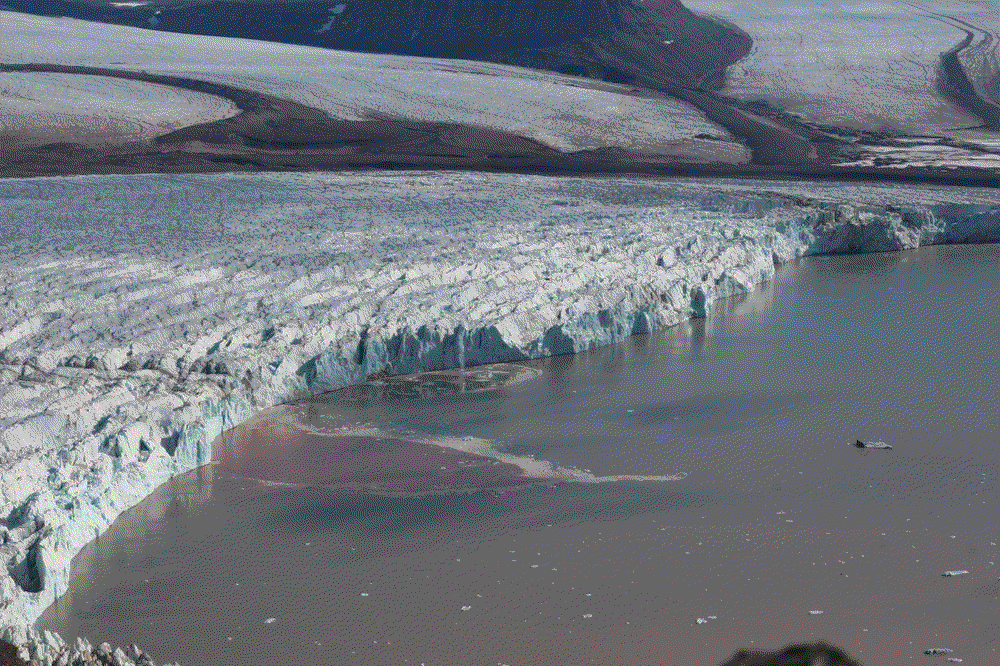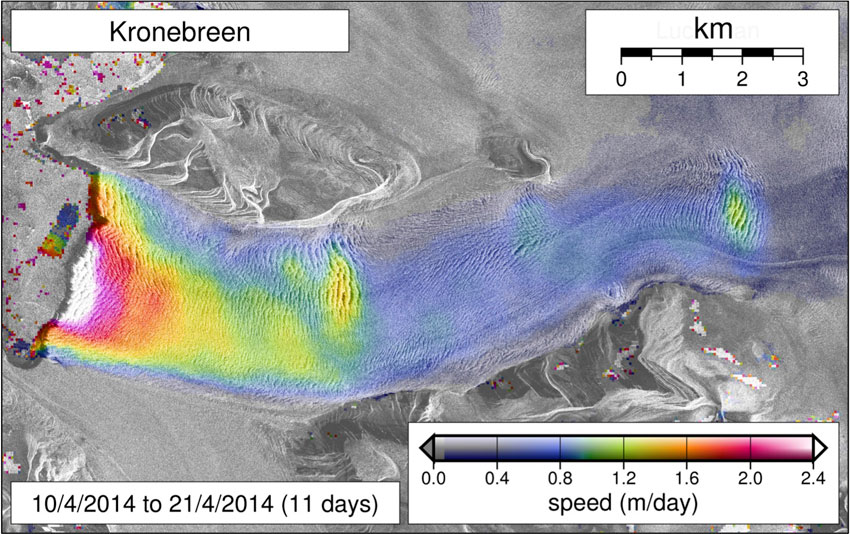Using meltwater plumes to infer subglacial hydrology at tidewater glaciers
PhD update: January 2017. Meltwater plumes are the upwelling of fresh water in front of a tidewater glacier. These are known to influence submarine melt rates, which are suggested to have a significant impact on the calving rate of glaciers that terminate in sea water. Recent work has suggested that meltwater plumes can also be used to infer the subglacial hydrology at the front of a glacier.
At land-terminating glaciers, water is evacuated via flow outlets which form large rivers on the adjacent land. It is therefore relatively straightforward to measure the amount of water leaving the glacial system. Things are a bit more complicated at glaciers which terminate in water (i.e. a fjord, sea, or ocean). Fresh water exits from the glacier at depth and interacts with the salty seawater. The fresh water moves upwards due to the density difference between freshwater and saltwater, forming a turbulent column of mixing water. This is a meltwater plume (and can also be referred to as a 'submarine plume', or simply just a 'plume').

An example of a surfacing meltwater plume at Tunabreen, a tidewater glacier in Svalbard. Note the distinctive shape and the dark colour (indicating sediment content) of the surface expression.
The freshwater in a meltwater plume will continue to flow up through the water column and entrain surrounding saltwater until it is thoroughly mixed (i.e. there is no difference in the density between the plume and the surrounding water). At this point, a meltwater plume will reach its neutral buoyancy and the water will cease flowing upwards and flow horizontally away from the glacier front.
A meltwater plume can reach the sea surface if the neutral buoyancy exceeds the depth of the fjord. The surface expression of a meltwater plume is normally very distinctive, distinguished by its sediment-laden colour and turbulent flow away from the glacier. We have lovely images of meltwater plume activity at Tunabreen, a tidewater glacier in Svalbard, showing a surfacing plume which has entrained very rich red/brown sediment.
The neutral buoyancy point of a meltwater plume is influenced by a number of factors:
- The temperature/density difference between the freshwater in the plume and the surrounding saltwater
- The geometry of the fjord, such as how deep it is
- The stratification of the surrounding saltwater
- The rate at which meltwater is exiting the glacier (also referred to as discharge)
The first three of these listed influences undergo relatively little change compared to discharge over short time-scales (e.g. a summer season). Assuming this, the activity of a meltwater plume can be used as a signal for the rate at which meltwater is exiting a glacier over the course of a melt season.
Meltwater typically exits into a fjord/sea/ocean at the bed of a glacier. The meltwater can either be directed through a given number of big channels or a series of intricate, small cavities. Channels can typically accommodate large volumes of meltwater, hence they are known as an efficient drainage system. Linked cavities are not as effective at transporting meltwater and tend to hold water at the bed for much longer durations, so they are aptly referred to as an inefficient drainage system.

A meltwater plume at the front of Kronebreen, a fast-flowing tidewater glacier in Svalbard. The surfacing plume is situated on the north side of the plume (left side of the terminus in this image). This plume entrains sediment which gives it a red/brown colour. A plume also surfaced intermittently on the south side of the terminus during the melt season of 2014 (not pictured here). Photo taken: September 2016.

Timeline of surfacing plume activity at Kronebreen, Svalbard, monitored from time-lapse imagery. Activity began on the 23 June and continued through till the end of September. Plumes P1, P2 and P3 were present at the north side of the terminus. P1 (pictured in the above image) was active for the entire monitoring period (gaps are where there was no visibility in the time-lapse imagery). Plume P4 surfaced at the south side of the terminus, showing intermittent activity throughout the melt season.
An efficient drainage system can quickly channel a large volume of meltwater into the adjacent sea water. It is therefore likely that the neutral buoyancy of a meltwater plume from an efficient drainage system can exceed the depth of the fjord, so the plume will surface and will be visible. An inefficient drainage system is much more limited in the rate at which it can deliver meltwater into the adjacent sea water. It is therefore likely that the neutral buoyancy of a meltwater plume from an inefficient drainage system will be at depth, so the plume will not surface and will not be visible. We can thus infer what type of drainage system is present at the front of a glacier by monitoring meltwater plume activity over short durations.
We have been monitoring meltwater plume activity at the front of Kronebreen, a fast-flowing tidewater glacier in Svalbard. Two sets of plumes were present over the 2014 melt season, on the north and south side of the terminus. It is assumed here that a meltwater plume is likely to surface in the fjord if a channel is active based on the known fjord depth (∼80 m) and modelled runoff outputs. The set of plumes on the north side of the terminus persistently surfaced throughout the melt season, whereas the plume on the south side only surfaced intermittently.
A plume may not be able to consistently surface because meltwater is not leaving the glacier through a stable efficient drainage system. This could suggest that two different drainage systems preside at the north and south side of the glacier - a stable efficient drainage system on the north side, and an unstable system that switches between efficient and inefficient drainage on the south side.

A velocity map of Kronebreen over an 11-day period in April 2014 (Luckman et al., 2015). These velocities are derived from feature tracking between image pairs, and these images are TerraSAR-X satellite images. Higher surface velocities are present at the central/south side of the terminus compared to the north side. This is possibly related to a difference in subglacial drainage beneath these two regions. Source: UNIS
In this situation, you would expect to see other differences between the north and south side of the terminus such as surface velocity. A large amount of subglacial meltwater is in contact with the bed in an inefficient drainage system, which enhances lubrication at the bed and promotes ice sliding. In an efficient drainage system, the water is channelled through a discrete area of the glacier and thus there is less basal lubrication as a smaller amount is in contact with the bed.
Surface velocities over the 2014 melt season show a distinct difference between the north and south side of the glacier terminus - the south is much faster flowing than the north, with the south exceeding velocities of 4 metres per day whilst the north remains relatively slow (see an example velocity map above). It is likely that a difference in drainage efficiency could facilitate this difference in surface velocities. The presence of an inefficient drainage system at the south side of the glacier tongue may be promoting faster velocities.
This idea is being further explored with additional datasets to better understand glacier hydrology and dynamics. The main take-home message from this post is that meltwater plume activity could be a reliable signal for meltwater outflow. This activity can be effectively monitored using time-lapse photography. Observations of plume activity can help us to diagnose the nature of subglacial drainage beneath tidewater glaciers, which is not accessible for direct measurements at this time. Kronebreen appears to have two different drainage systems active near the glacier terminus, as reflected in the differing plume activity, and this could be facilitating fast velocities in discrete areas of the glacier.
Further reading
Slater et al., 2017
A newly-published study looked at meltwater plume activity at Kangiata Nunata Sermia (KNS) in Southwest Greenland using an in-situ time-lapse camera. They predicted from model simulations that a meltwater plume from a single channel should be able to surface in the adjacent fjord water, knowing the rate of discharge through the drainage system. However, the time-lapse imagery showed that the meltwater plume was only visible for brief periods throughout a melt season (May to September 2009). They argued that a plume was not consistently surfacing because meltwater may not leaving the glacier through a stable efficient drainage system. An efficient drainage system may not be able to persist at the front of KNS because it could be repeatedly disrupted by basal deformation, which is facilitated by the fast-flowing nature of the glacier. This paper has been neatly summarised by >ice2ice.
Time-lapse sequences from Kronebreen. Note the visible plume activity seen from cameras 1 and 2 through the melt season.
